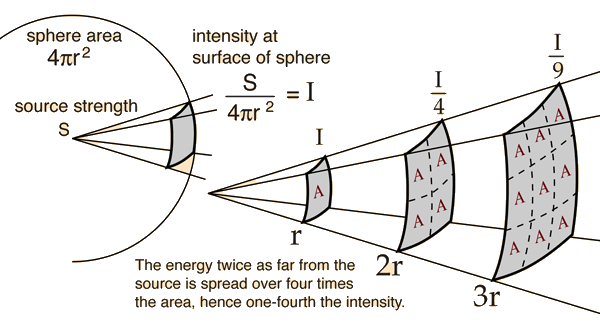- Forum
- Photography and Camera Forum
- Taking the Photo | Editing | The art of Photography!
- Beginner Photography Forum
- Is there an easy way to understand inverse square law?
Is there an easy way to understand inverse square law?
-
 Topic Author
Topic Author
- Tsoto
- Lone Wolf
-
- Nikon 5100
- Followers: 29
- Posts: 119
-
Points:
818
Post #246343
I'm completely lost and need some help understanding this. So if I double the distance between my flash and a surface that is reflecting that the light from my flash the intensity drops 1/4?
Is that how it works?
-

- KCook
- Photo Elder
-
- Canon EOS 50D and Olympus E-P5
- Followers: 1325
- Posts: 5410
-
Points:
32913
-

- John Landolfi
- Super User
-
- Nikon D3S, D7100, Sony RX10, Canon G11, F4s, F2sb, RetinaflexIV etc, etc
- Followers: 1205
- Posts: 21605
-
Points:
40394
Post #246369
Let's call
I=actual intensity of light
O=Flash output
d=distance to subject.
The law says that I=O/(d squared)
If the distance doubles to 2d, then you have to divide by (2d)squared. So
I=O/(2d)squared=O/4(d squared), So the intensity falls by a factor of 4.
If the distance trebles to 3d, then you divide by (3d)squared=9(d squared), so the intensity falls by a factor of 9.
And so on.
-

- John Landolfi
- Super User
-
- Nikon D3S, D7100, Sony RX10, Canon G11, F4s, F2sb, RetinaflexIV etc, etc
- Followers: 1205
- Posts: 21605
-
Points:
40394
Post #246449
-

- KCook
- Photo Elder
-
- Canon EOS 50D and Olympus E-P5
- Followers: 1325
- Posts: 5410
-
Points:
32913
Post #246482
www.cambridgeincolour.com/tutorials/diff...ion-photography.htm/
Kelly
-

- John Landolfi
- Super User
-
- Nikon D3S, D7100, Sony RX10, Canon G11, F4s, F2sb, RetinaflexIV etc, etc
- Followers: 1205
- Posts: 21605
-
Points:
40394
Post #246511
-

- Henry Peach
- Apprentice
-
- I currently use a 5DII or Sony Nex-3 most of the time.
- Followers: 50
- Posts: 2925
-
Points:
16
Post #247525
Tsoto wrote: So if I double the distance between my flash and a surface that is reflecting that the light from my flash the intensity drops 1/4?
Yep. 2 stops ( 1 stop is double or half the light). 1/2 x 1/2 = 1/4th.
-

- Stealthy Ninja
- Moderator
-
- Fuji X stuff and a 1DsIII for some reason
- Followers: 982
- Posts: 16300
-
Points:
6837
-

- KCook
- Photo Elder
-
- Canon EOS 50D and Olympus E-P5
- Followers: 1325
- Posts: 5410
-
Points:
32913
-

- Stealthy Ninja
- Moderator
-
- Fuji X stuff and a 1DsIII for some reason
- Followers: 982
- Posts: 16300
-
Points:
6837
-

- Brad Eckel Photography
- Newbie
- Follower: 1
- Posts: 2
-
Points:
0
Post #247719
check this site out from NASA. I have not posted on here before so it would let me do the entire link... so put the 3w's and the dot in front of it.
imagine.gsfc.nasa.gov/YBA/M31-velocity/1overR2-more.html
-

- Brad Eckel Photography
- Newbie
- Follower: 1
- Posts: 2
-
Points:
0
Post #247729
From basic math a circle uses the radius sqaured and a sqaure has two equal sides. When calculating the area of these, the area becomes larger non linearily due to the squaring of the radius or multiply of the length times the width (since L=W in a sqaure L x W = L x L = L^2 (or L sqaured). Similarly in ALL units of measure for an area for instance a room is measure in feet squared.
Light spreads out from... more or less... a single "flash" point, in straight, but not in parallel lines. Light, is a form of energy, which once the flash is activated is sent out on various angles from the flash point. This engery value does not increase or decrease, but merely gets dispersed over a larger area as it travels further away from the flash point (until it hits an object and is either absorded, reflected or refracted... another story)
In the NASA diagram, you will see each progressively larger area shades lighter as the distance increase from the from the flash point.
Note: "flash" point, can be replaced for any light source (lamp, reflector, sun etc) base princple is still the same.
-

- John Landolfi
- Super User
-
- Nikon D3S, D7100, Sony RX10, Canon G11, F4s, F2sb, RetinaflexIV etc, etc
- Followers: 1205
- Posts: 21605
-
Points:
40394
Post #247798
-

- Crammer
- Photography Hooked
-
- Nikon D810 & D90
- Followers: 139
- Posts: 944
-
Points:
7875
Post #249406
John Landolfi wrote: Let me try:
Let's call
I=actual intensity of light
O=Flash output
d=distance to subject.
The law says that I=O/(d squared)
If the distance doubles to 2d, then you have to divide by (2d)squared. So
I=O/(2d)squared=O/4(d squared), So the intensity falls by a factor of 4.
If the distance trebles to 3d, then you divide by (3d)squared=9(d squared), so the intensity falls by a factor of 9.
And so on.
-

- John Landolfi
- Super User
-
- Nikon D3S, D7100, Sony RX10, Canon G11, F4s, F2sb, RetinaflexIV etc, etc
- Followers: 1205
- Posts: 21605
-
Points:
40394
Post #249527
- Forum
- Photography and Camera Forum
- Taking the Photo | Editing | The art of Photography!
- Beginner Photography Forum
- Is there an easy way to understand inverse square law?
Latest Reviews
The Olympus Pen E-P7 is an affordable micro four thirds mirrorless camera with 4K video capabilities, a 20.3MP sensor, and 121 focus points, making it a solid entry-level camera for beginners.
The Panasonic G9 II is a 25.2-megapixel micro four thirds camera with numerous features that make it punch out of its weight class, like 779 AF points, 5.8K video, and weather sealing.
The Fujifilm XT5 is a 40MP mirrorless camera capable of 6.2K video at 30p. With those specs, it’s an ideal choice for photographers needing a camera to pull double duty for imaging and video.
The Canon EOS R100 is an entry-level mirrorless camera introduced in 2023. But just because it’s an entry-level camera doesn’t mean it’s a bare-bones camera. Find out why in this review!
Latest Articles
Upgrade your kit in 2024 with the best intermediate camera on the market! The question is, what camera fits the bill? We’ve got three top options for you to choose from in this buyer’s guide.
The best photography jobs right now are a mix of tried-and-true gigs like wedding photography and new jobs highlighting AI’s capabilities, travel, and videography.
The Olympus Pen E-P7 is an affordable micro four thirds mirrorless camera with 4K video capabilities, a 20.3MP sensor, and 121 focus points, making it a solid entry-level camera for beginners.
Starting a photography business is one thing; sustaining your business over a long period of time is another. Use the tips in this professional photography guide to build something with longevity!
The Panasonic G9 II is a 25.2-megapixel micro four thirds camera with numerous features that make it punch out of its weight class, like 779 AF points, 5.8K video, and weather sealing.
Cinematic photography is an interesting genre that combines photographic and videographic skills along with effective storytelling techniques. The result? Highly impactful images!
Newborn photography requires skill, the right gear, and a lot of patience. This beginner’s guide discusses critical topics that will help you be more prepared for before, during, and after the shoot.
To fill the frame means to expand the footprint of the subject in your shot. Get in close, zoom in, crop the image, or use other techniques to bring the subject to the forefront.



















